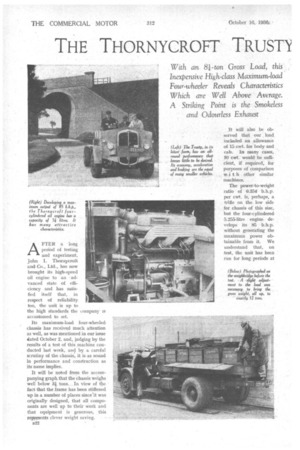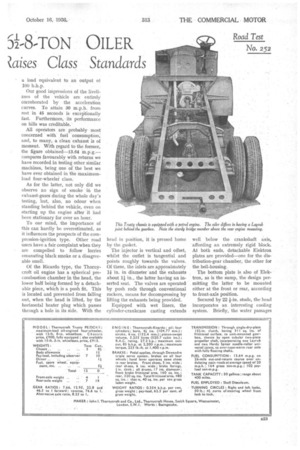THE THORNYCROFT TRUSTY
Page 60

Page 61

Page 62

Page 63

If you've noticed an error in this article please click here to report it so we can fix it.
5-1-8-TON OILER Zaises Class Standards
With an 81-ton Gross Load, this inexpensive High-class Maximum-load Four-wheeler Reveals Characteristics Which are Well Above Average. A Striking Point is the Smokeless
and. Odourless Exhaust •
FTER a long period of testing and experiment, John T. Thornycroft and Co., Ltd., has now brought its high-speed oil engine to an advanced state of efficiency and has sailsfled itself that, in respect of reliability too, the unit is up to the high standards the company is accustomed to set.
Its maximum-load four-wheeled chassis has received much attention as well, as was mentioned in our issue dated October 2, and, judging by the results of a test of this machine conducted last week, and by a. careful scrutiny of the chassis, it is as sound in performance and construction as its name implies.
It will be noted from the accompanying graph that the chassis weighs well below 3/ tons. In view of the fact that the frame has been stiffened up in a number of places since'it was originally designed, that all components are well up to their work and that equipment is generous, this represents clever weight saving. n22 It will also be observed that our load included an allowance of 15cwt. for body and cab. In many cases, 10 cwt. would be sufficient, if required, for purposes of comparison wi t .h other similar machines.
The power-to-weight ratio of 0:354 b.h.p. per cwt. is, perhaps, a trifle on the low side for chassis of this size, but the four-cylindered 5.255-litre engine develops its 85 b.h.p. without generating the maximum power obtainable from it. We understand that, on test, the unit has been run for long periods at a. load equivalent to an output ot 100 b.h.p.
Our good impressions of the liveliness of the vehicle are entirely corroborated by the acceleration curves. To attain 30 m.p.h. from rest in 45 seconds is excePtionally fast. Furthermore, its performance on hills was creditable.
All operators are probably most concerned with fuel. 'consumption,' and, to many, a clean exhaust is of moment. With regard to the former; the figure obtained-13.64 m.p.g.— compares favourably with returns we have recorded in testing other similar machines, being one of .the best we have ever obtained in the inaxirnurnload four-wheeler class.
As for the latter, not only did we observe no sign of smoke in the exhaust-gases during the whole day's testing, but, also, no odour when standing behind the vehicle, even on starting up the engine after it had been stationary for over an hour.
To our mind, the importance of this can hardly be overestimated, as it influences the prospects of the compression-ignition type. Other road users have a fair complaint when they are compelled to follow lorries emanating black smoke or a disagreeable smell.
Of the Ricardo type, the Thornycroft oil engine has a spherical precombustion chamber in the head, the lower half being formed by a detachable piece, which is a push fit.. This is located and prevented from failing out, when the head is lifted, by the horizontal heater plug which passes through a hole in its side. With the head in position, it is pressed home by the gasket.
The injector is vertical and offset, whilst the outlet is tangential and points roughly towards the valves. Of these, the inlets are approximately 1i in. in diameter and the exhausts about 11 in., the latter having an inserted seat. The valves are operated by push rods through conventional rockers, means for decompressing by lifting the exhausts being provided.
Equipped with wet liners, the cylinder-crankcase casting extends well below the crankshaft axis, affording an extremely rigid block. At both ends, detachable Elektron plates are provided—one for the distribution-gear chamber, the other for the bell-housing.
The bottom plate is also of Elektron, as is the sump, the design permitting the latter to be mounted either at the front or rear, according to front-axle position.
Secured by 22 /-in. studs, the head incorporates an interesting cooling system. Briefly, the water passages are no arranged that a jet is directed between each pre-combustion chamber and the corresponding valve ports. This, we are informed, has entirely eliminated an early head trouble.
Mounted in five bearings, the crankshaft has hollow main journals and balance weights. Steel-backed lead-bronze bearings are used in the big-end top halves, the caps being white-metal lined. Pistons and gudgeon pins are lubricated by splash. The auxiliaries include a C.A.V. -Bosch injection pump and a Williams and James exhauster.
One of our illustrations shows the general layout of the chassis, but it should be noted that the vehicle illustrated has a petrol engine, and the transmission differs in one feature.
Behind the gearbox, on the oiler, there is a large Layrub universal joint, the other two being of HardySpicer make, as in the picture. In other respects, bar the power unit of course, the two chassis are practically identical. This rubber coupling serves to absorb torsional vibration, and is, as it were, complementary to the three rubber-cushioned engine bearers.
With regard to the frame improvements mentioned earlier, these comprise, in the main, the extending of certain cross-member ends to the full depth of the longitudinals, and the employment of larger gussets. The member at the extreme front is sturdier throughout.
Finally, there is a small, but im
portant, modification to the brake system that is worthy of mention. Single master adjusters for the hand and foot mechanisms are now pro
vided. Individually set before the chassis leaves the works, the brakes can be taken up subsequently by these main adjusting devices without affecting their equalization.
For the consumption test, the machine was driven from a point on the
London side of Basingstoke, by the main road, to Bhickwater and back, a distance of 26 miles by the milestones, which exactly agreed with the speedometer reading... Precisely 1 gallon 71 pints were consumed, which works out at 13.64 m.p.g. The hills on this route necessitated the use of third gear on three occasions, whilst on the •outward run a strong • head wind prevailed.
On Farleigh Hill, a few miles from Basingstoke, which is a stiff climb with a maximum gradient of about 1 in 8, the Trusty averaged 12.5 m.p.h. up its 1.2-mile slope. On the steepest portion first gear was required for about one-tenth of a mile. The downward changes from the higher to the next lower gears were made at about 18 m.p.h., 10 m.p.h. and 5 m.p.h. respectively. At the summit the temperature of the cooling water was 182 degrees F., a portion of the radiator being blanked off.
Later, we ascertained that the hand brake held the laden vehicle on the 1-in-8 section and that the machine was capable of starting from rest on this gradient. We are informed that
a climb of 1 in 5i has successfully
been accomplished. A lower axle ratio is available.
The results of our braking and acceleration tests are shown graphically. To the latter we have already referred; the former are extremely good. A stopping distance of 36 ft. from 25 m.p.h. is equivalent to 60 per cent, braking efficiency and is classed by Ferodo, Ltd., as "very good" for all classes of motor vehicle.
Translated into feet from 30 m.p.h., the distance would be 50 ft., and throughout the range of average figures for all classes of goods vehicle compiled from "CM." road tests and published in our issue dated July 17 last, 50 ft. is only once bettered.
Thus is further evidence supplied of the futility of the 20-m.p.h. limit for vehicles weighing over 21 tons.
When, a week or two ago, sve-tried a new Trusty for a few miles in London, we found the clutch pedal
unduly heavy to operate.: We anticipated the same fault on the vehicle submitted for our standardized test. However, we found no cause for criticism and, subsequently raising the point at the works, learned that this was yet another detail to which improvement had been effected.
In other respects, from the driver's viewpoint, control of the vehicle is easy. Steering is light and certain, whilst gear changing calls for no special effort or skill. Engine responsiveness always seems to us to have a bearing on the physical state of the driver. The Thornycroft power unit gives the impression of making light of its job.
When testing a chassis it is difficult to assess engine noise to standards fixed for the cab of a forward-control lorry. However, we would class the unit under consideration as medium, being quieter than some but noisier than others, but we doubt whether even an expert could determine the type of engine installed by any other sense than hearing.
Thornycroft products are built individually. Moreover, every engine has at least a day's bench test and every chassis a thorough trial on the road. Unless it comes up to the test department's standards which demand returns little, if any, lower thau those we ourselves obtained, the vehicle is not passed out.
Despite this rigid policy, and despite the quality of design, material, workmanship and equipment, the price is not greatly in excess of that of the cheapest comparable chassis on the British market. On all counts the Trusty seems to be an attractive proposition.








































































































